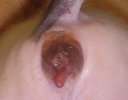Zearalenone toxicosis
It is an estrogenic toxin that appears in corn and is produced by Fusarium graminearum, which requires high levels of moisture for its replication and toxin production.
Alternative names: Micotoxins, zearalenone, F-2 toxin, ZEA, Fusarium graminearum, Fusarium roseum
Information
Zearalenone is a toxin with estrogenic effects. It is produced during periods of high humidity and when there are sharp changes between daytime and nighttime temperatures. This mycotoxin can also be produced during the storage of grain / feed. The clinical condition affects primarily females.
Symptoms
Boars
- The sperm can be affected if levels in the feed are above 30 ppm, but it does not affect fertility. Higher levels can lead to a decrease in libido, edema of the foreskin, and hair loss.
Sows
- Variable duration of estrus.
- Anoestrus may be associated with pseudo gestation due to the retention of the corpus luteum. The F2 toxin will not usually cause abortion.
- If sows are exposed during the implantation period, the litter size can be reduced.
- The vulva of sows may increase in size during lactation.
- Effect on gestation: when levels are above 30 ppm, there is complete loss of embryos between implantation and thirty days, followed by pseudo gestation. Low levels may not affect the first half of gestation but in the final stages, it can slow the growth of piglets in the uterus. The vulvas of some sows may increase in size.
- Effect on lactation: Low levels have no effect during lactation but the wean to service interval can be longer.
Nursery and fattening (only in females)
- Swelling and redness of vulva, enlargement of nipples and mammary glands. In young growing females, rectal and vaginal prolapse can be observed.
Causes / Contributing Factors
- Crops affected by high humidity levels and low temperatures.
Diagnosis
- Clinical presentation, especially redness of vulva in young females. Identify the presence of the toxin in grain or feed.
Control/Prevention
- Removal of suspected feed.
- Maintain low humidity prior to and during storage.
- Use absorptive products in feed.
Atlas of pathology
See images in the Altlas related to Zearalenone toxicosis







